Analyzing the Impact of Financial Management on Manufacturing Industry
VerifiedAdded on 2020/07/23
|17
|4325
|52
AI Summary
The assignment provided is a detailed analysis of the financial management practices in the manufacturing industry. It includes a review of various academic sources, such as journal articles and books, that discuss the importance of sound budgeting and financial management practices at the decentralised level of public administration. The assignment also examines the role of financial and non-financial evaluation measures in the process of management control over foreign subsidiaries. Additionally, it analyzes the financial statements of two Australian companies, Asaleo Care Ltd. and Brickworks Ltd., to assess their profitability, liquidity, efficiency, and debt ratios. The assignment concludes by discussing the major economic factors that affect businesses drastically.
Contribute Materials
Your contribution can guide someone’s learning journey. Share your
documents today.

PRINCIPLE FINANCIAL
MANAGEMENT
MANAGEMENT
Secure Best Marks with AI Grader
Need help grading? Try our AI Grader for instant feedback on your assignments.
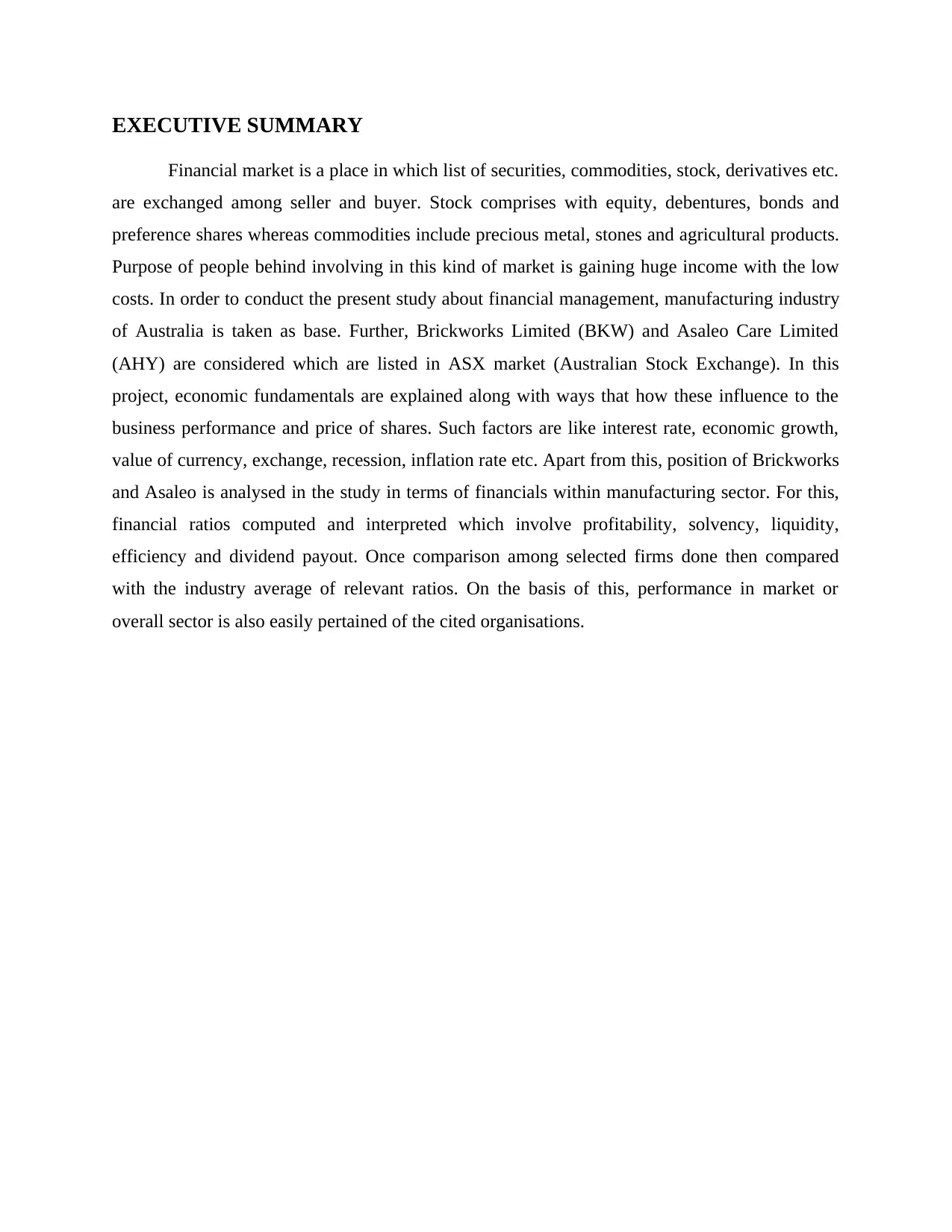
EXECUTIVE SUMMARY
Financial market is a place in which list of securities, commodities, stock, derivatives etc.
are exchanged among seller and buyer. Stock comprises with equity, debentures, bonds and
preference shares whereas commodities include precious metal, stones and agricultural products.
Purpose of people behind involving in this kind of market is gaining huge income with the low
costs. In order to conduct the present study about financial management, manufacturing industry
of Australia is taken as base. Further, Brickworks Limited (BKW) and Asaleo Care Limited
(AHY) are considered which are listed in ASX market (Australian Stock Exchange). In this
project, economic fundamentals are explained along with ways that how these influence to the
business performance and price of shares. Such factors are like interest rate, economic growth,
value of currency, exchange, recession, inflation rate etc. Apart from this, position of Brickworks
and Asaleo is analysed in the study in terms of financials within manufacturing sector. For this,
financial ratios computed and interpreted which involve profitability, solvency, liquidity,
efficiency and dividend payout. Once comparison among selected firms done then compared
with the industry average of relevant ratios. On the basis of this, performance in market or
overall sector is also easily pertained of the cited organisations.
Financial market is a place in which list of securities, commodities, stock, derivatives etc.
are exchanged among seller and buyer. Stock comprises with equity, debentures, bonds and
preference shares whereas commodities include precious metal, stones and agricultural products.
Purpose of people behind involving in this kind of market is gaining huge income with the low
costs. In order to conduct the present study about financial management, manufacturing industry
of Australia is taken as base. Further, Brickworks Limited (BKW) and Asaleo Care Limited
(AHY) are considered which are listed in ASX market (Australian Stock Exchange). In this
project, economic fundamentals are explained along with ways that how these influence to the
business performance and price of shares. Such factors are like interest rate, economic growth,
value of currency, exchange, recession, inflation rate etc. Apart from this, position of Brickworks
and Asaleo is analysed in the study in terms of financials within manufacturing sector. For this,
financial ratios computed and interpreted which involve profitability, solvency, liquidity,
efficiency and dividend payout. Once comparison among selected firms done then compared
with the industry average of relevant ratios. On the basis of this, performance in market or
overall sector is also easily pertained of the cited organisations.
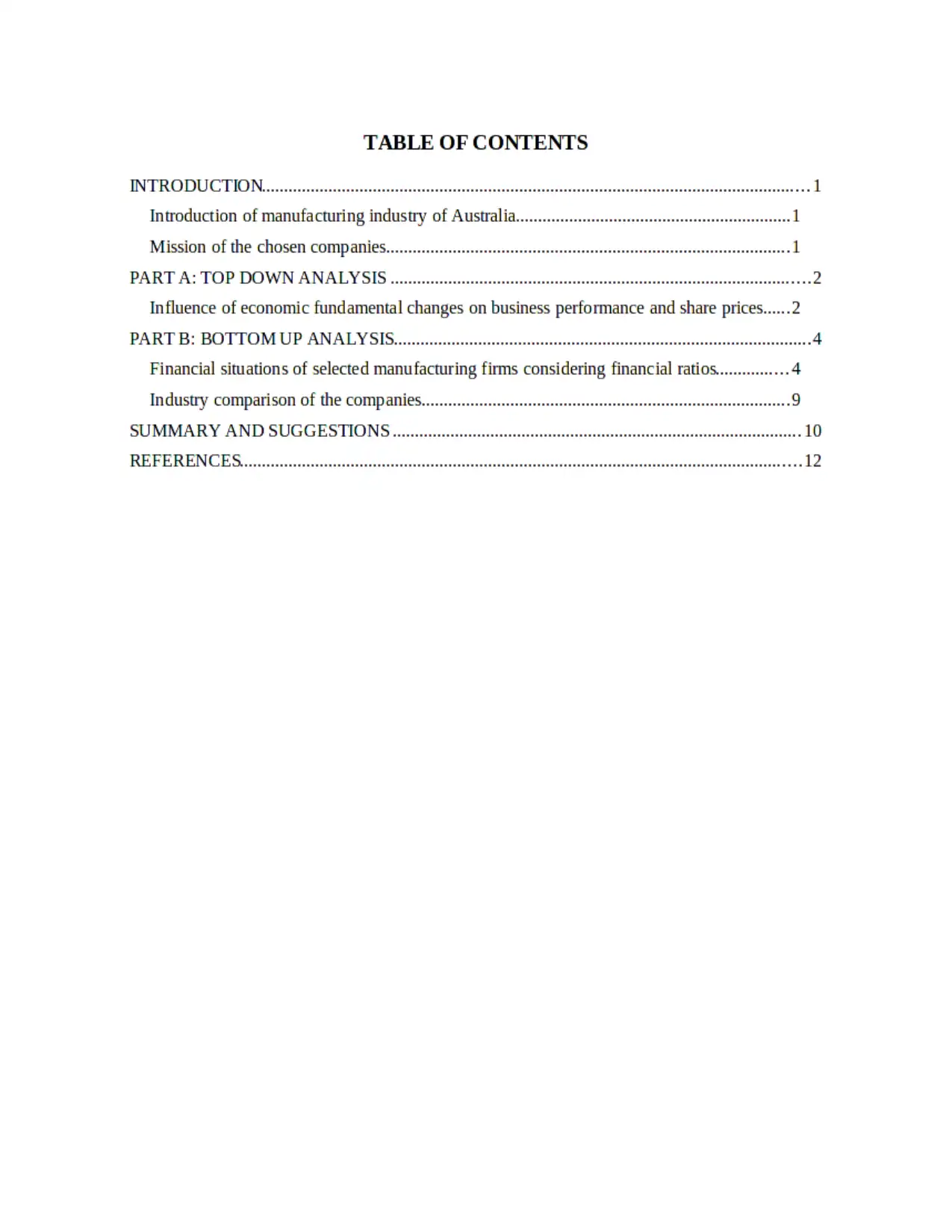
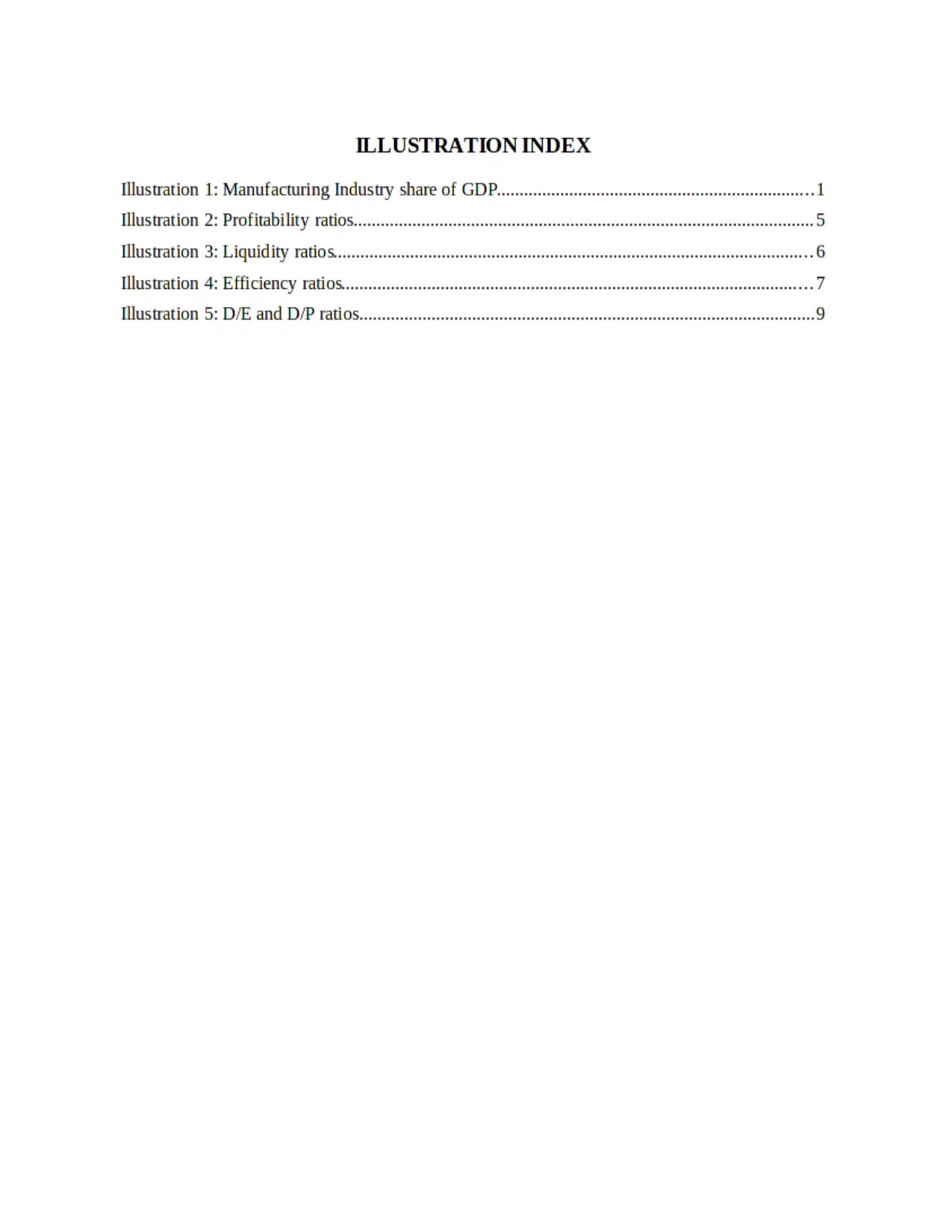
Secure Best Marks with AI Grader
Need help grading? Try our AI Grader for instant feedback on your assignments.
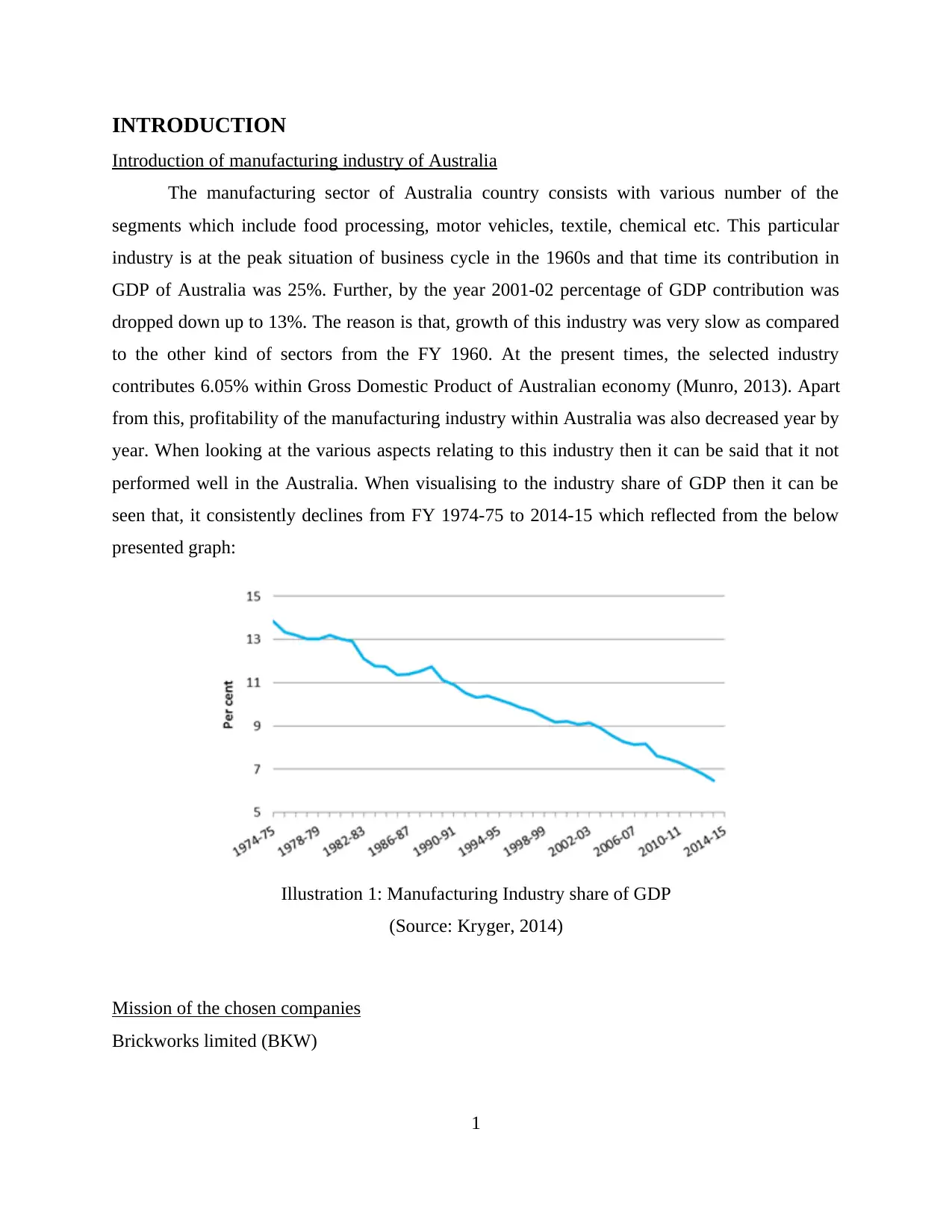
INTRODUCTION
Introduction of manufacturing industry of Australia
The manufacturing sector of Australia country consists with various number of the
segments which include food processing, motor vehicles, textile, chemical etc. This particular
industry is at the peak situation of business cycle in the 1960s and that time its contribution in
GDP of Australia was 25%. Further, by the year 2001-02 percentage of GDP contribution was
dropped down up to 13%. The reason is that, growth of this industry was very slow as compared
to the other kind of sectors from the FY 1960. At the present times, the selected industry
contributes 6.05% within Gross Domestic Product of Australian economy (Munro, 2013). Apart
from this, profitability of the manufacturing industry within Australia was also decreased year by
year. When looking at the various aspects relating to this industry then it can be said that it not
performed well in the Australia. When visualising to the industry share of GDP then it can be
seen that, it consistently declines from FY 1974-75 to 2014-15 which reflected from the below
presented graph:
Illustration 1: Manufacturing Industry share of GDP
(Source: Kryger, 2014)
Mission of the chosen companies
Brickworks limited (BKW)
1
Introduction of manufacturing industry of Australia
The manufacturing sector of Australia country consists with various number of the
segments which include food processing, motor vehicles, textile, chemical etc. This particular
industry is at the peak situation of business cycle in the 1960s and that time its contribution in
GDP of Australia was 25%. Further, by the year 2001-02 percentage of GDP contribution was
dropped down up to 13%. The reason is that, growth of this industry was very slow as compared
to the other kind of sectors from the FY 1960. At the present times, the selected industry
contributes 6.05% within Gross Domestic Product of Australian economy (Munro, 2013). Apart
from this, profitability of the manufacturing industry within Australia was also decreased year by
year. When looking at the various aspects relating to this industry then it can be said that it not
performed well in the Australia. When visualising to the industry share of GDP then it can be
seen that, it consistently declines from FY 1974-75 to 2014-15 which reflected from the below
presented graph:
Illustration 1: Manufacturing Industry share of GDP
(Source: Kryger, 2014)
Mission of the chosen companies
Brickworks limited (BKW)
1
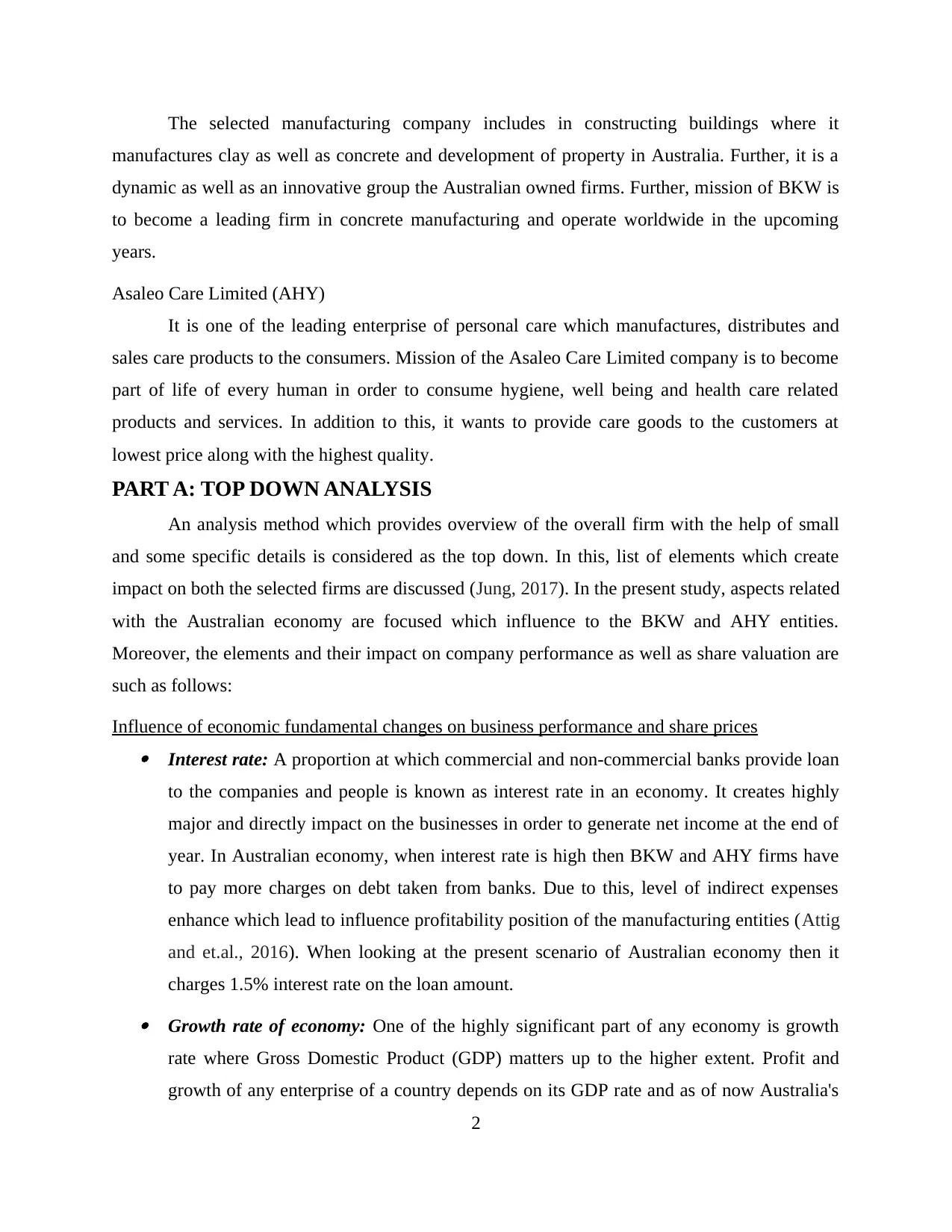
The selected manufacturing company includes in constructing buildings where it
manufactures clay as well as concrete and development of property in Australia. Further, it is a
dynamic as well as an innovative group the Australian owned firms. Further, mission of BKW is
to become a leading firm in concrete manufacturing and operate worldwide in the upcoming
years.
Asaleo Care Limited (AHY)
It is one of the leading enterprise of personal care which manufactures, distributes and
sales care products to the consumers. Mission of the Asaleo Care Limited company is to become
part of life of every human in order to consume hygiene, well being and health care related
products and services. In addition to this, it wants to provide care goods to the customers at
lowest price along with the highest quality.
PART A: TOP DOWN ANALYSIS
An analysis method which provides overview of the overall firm with the help of small
and some specific details is considered as the top down. In this, list of elements which create
impact on both the selected firms are discussed (Jung, 2017). In the present study, aspects related
with the Australian economy are focused which influence to the BKW and AHY entities.
Moreover, the elements and their impact on company performance as well as share valuation are
such as follows:
Influence of economic fundamental changes on business performance and share prices Interest rate: A proportion at which commercial and non-commercial banks provide loan
to the companies and people is known as interest rate in an economy. It creates highly
major and directly impact on the businesses in order to generate net income at the end of
year. In Australian economy, when interest rate is high then BKW and AHY firms have
to pay more charges on debt taken from banks. Due to this, level of indirect expenses
enhance which lead to influence profitability position of the manufacturing entities (Attig
and et.al., 2016). When looking at the present scenario of Australian economy then it
charges 1.5% interest rate on the loan amount. Growth rate of economy: One of the highly significant part of any economy is growth
rate where Gross Domestic Product (GDP) matters up to the higher extent. Profit and
growth of any enterprise of a country depends on its GDP rate and as of now Australia's
2
manufactures clay as well as concrete and development of property in Australia. Further, it is a
dynamic as well as an innovative group the Australian owned firms. Further, mission of BKW is
to become a leading firm in concrete manufacturing and operate worldwide in the upcoming
years.
Asaleo Care Limited (AHY)
It is one of the leading enterprise of personal care which manufactures, distributes and
sales care products to the consumers. Mission of the Asaleo Care Limited company is to become
part of life of every human in order to consume hygiene, well being and health care related
products and services. In addition to this, it wants to provide care goods to the customers at
lowest price along with the highest quality.
PART A: TOP DOWN ANALYSIS
An analysis method which provides overview of the overall firm with the help of small
and some specific details is considered as the top down. In this, list of elements which create
impact on both the selected firms are discussed (Jung, 2017). In the present study, aspects related
with the Australian economy are focused which influence to the BKW and AHY entities.
Moreover, the elements and their impact on company performance as well as share valuation are
such as follows:
Influence of economic fundamental changes on business performance and share prices Interest rate: A proportion at which commercial and non-commercial banks provide loan
to the companies and people is known as interest rate in an economy. It creates highly
major and directly impact on the businesses in order to generate net income at the end of
year. In Australian economy, when interest rate is high then BKW and AHY firms have
to pay more charges on debt taken from banks. Due to this, level of indirect expenses
enhance which lead to influence profitability position of the manufacturing entities (Attig
and et.al., 2016). When looking at the present scenario of Australian economy then it
charges 1.5% interest rate on the loan amount. Growth rate of economy: One of the highly significant part of any economy is growth
rate where Gross Domestic Product (GDP) matters up to the higher extent. Profit and
growth of any enterprise of a country depends on its GDP rate and as of now Australia's
2
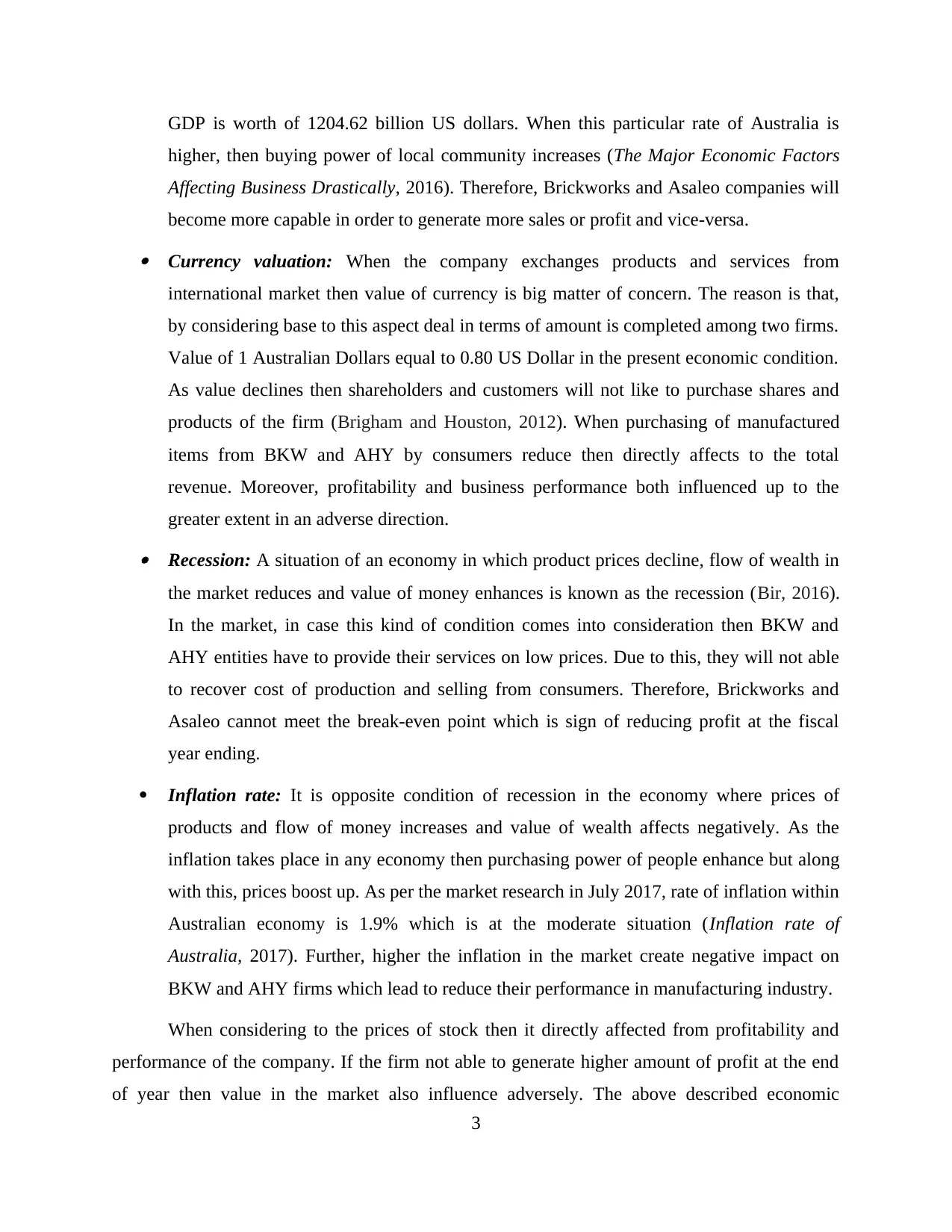
GDP is worth of 1204.62 billion US dollars. When this particular rate of Australia is
higher, then buying power of local community increases (The Major Economic Factors
Affecting Business Drastically, 2016). Therefore, Brickworks and Asaleo companies will
become more capable in order to generate more sales or profit and vice-versa. Currency valuation: When the company exchanges products and services from
international market then value of currency is big matter of concern. The reason is that,
by considering base to this aspect deal in terms of amount is completed among two firms.
Value of 1 Australian Dollars equal to 0.80 US Dollar in the present economic condition.
As value declines then shareholders and customers will not like to purchase shares and
products of the firm (Brigham and Houston, 2012). When purchasing of manufactured
items from BKW and AHY by consumers reduce then directly affects to the total
revenue. Moreover, profitability and business performance both influenced up to the
greater extent in an adverse direction. Recession: A situation of an economy in which product prices decline, flow of wealth in
the market reduces and value of money enhances is known as the recession (Bir, 2016).
In the market, in case this kind of condition comes into consideration then BKW and
AHY entities have to provide their services on low prices. Due to this, they will not able
to recover cost of production and selling from consumers. Therefore, Brickworks and
Asaleo cannot meet the break-even point which is sign of reducing profit at the fiscal
year ending.
Inflation rate: It is opposite condition of recession in the economy where prices of
products and flow of money increases and value of wealth affects negatively. As the
inflation takes place in any economy then purchasing power of people enhance but along
with this, prices boost up. As per the market research in July 2017, rate of inflation within
Australian economy is 1.9% which is at the moderate situation (Inflation rate of
Australia, 2017). Further, higher the inflation in the market create negative impact on
BKW and AHY firms which lead to reduce their performance in manufacturing industry.
When considering to the prices of stock then it directly affected from profitability and
performance of the company. If the firm not able to generate higher amount of profit at the end
of year then value in the market also influence adversely. The above described economic
3
higher, then buying power of local community increases (The Major Economic Factors
Affecting Business Drastically, 2016). Therefore, Brickworks and Asaleo companies will
become more capable in order to generate more sales or profit and vice-versa. Currency valuation: When the company exchanges products and services from
international market then value of currency is big matter of concern. The reason is that,
by considering base to this aspect deal in terms of amount is completed among two firms.
Value of 1 Australian Dollars equal to 0.80 US Dollar in the present economic condition.
As value declines then shareholders and customers will not like to purchase shares and
products of the firm (Brigham and Houston, 2012). When purchasing of manufactured
items from BKW and AHY by consumers reduce then directly affects to the total
revenue. Moreover, profitability and business performance both influenced up to the
greater extent in an adverse direction. Recession: A situation of an economy in which product prices decline, flow of wealth in
the market reduces and value of money enhances is known as the recession (Bir, 2016).
In the market, in case this kind of condition comes into consideration then BKW and
AHY entities have to provide their services on low prices. Due to this, they will not able
to recover cost of production and selling from consumers. Therefore, Brickworks and
Asaleo cannot meet the break-even point which is sign of reducing profit at the fiscal
year ending.
Inflation rate: It is opposite condition of recession in the economy where prices of
products and flow of money increases and value of wealth affects negatively. As the
inflation takes place in any economy then purchasing power of people enhance but along
with this, prices boost up. As per the market research in July 2017, rate of inflation within
Australian economy is 1.9% which is at the moderate situation (Inflation rate of
Australia, 2017). Further, higher the inflation in the market create negative impact on
BKW and AHY firms which lead to reduce their performance in manufacturing industry.
When considering to the prices of stock then it directly affected from profitability and
performance of the company. If the firm not able to generate higher amount of profit at the end
of year then value in the market also influence adversely. The above described economic
3
Paraphrase This Document
Need a fresh take? Get an instant paraphrase of this document with our AI Paraphraser
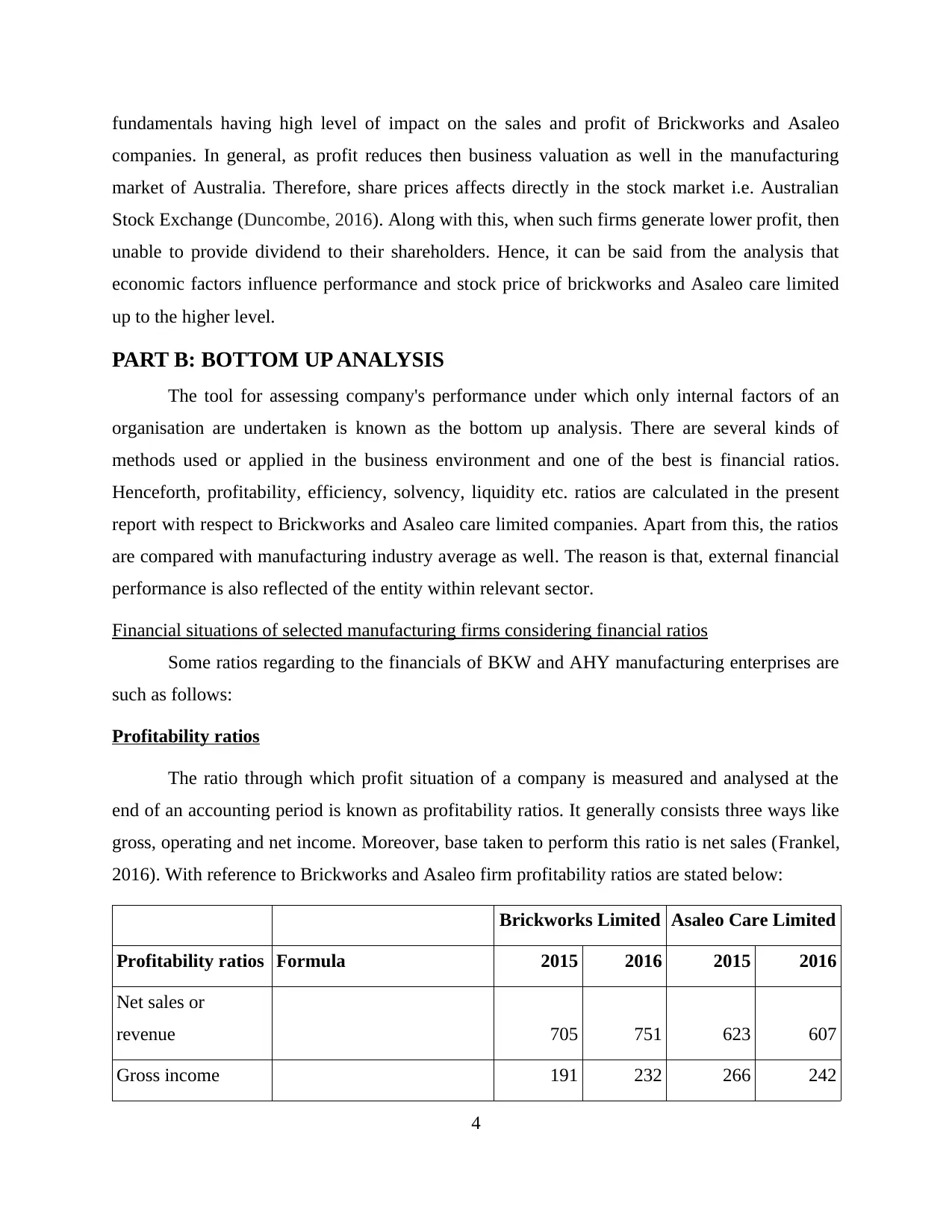
fundamentals having high level of impact on the sales and profit of Brickworks and Asaleo
companies. In general, as profit reduces then business valuation as well in the manufacturing
market of Australia. Therefore, share prices affects directly in the stock market i.e. Australian
Stock Exchange (Duncombe, 2016). Along with this, when such firms generate lower profit, then
unable to provide dividend to their shareholders. Hence, it can be said from the analysis that
economic factors influence performance and stock price of brickworks and Asaleo care limited
up to the higher level.
PART B: BOTTOM UP ANALYSIS
The tool for assessing company's performance under which only internal factors of an
organisation are undertaken is known as the bottom up analysis. There are several kinds of
methods used or applied in the business environment and one of the best is financial ratios.
Henceforth, profitability, efficiency, solvency, liquidity etc. ratios are calculated in the present
report with respect to Brickworks and Asaleo care limited companies. Apart from this, the ratios
are compared with manufacturing industry average as well. The reason is that, external financial
performance is also reflected of the entity within relevant sector.
Financial situations of selected manufacturing firms considering financial ratios
Some ratios regarding to the financials of BKW and AHY manufacturing enterprises are
such as follows:
Profitability ratios
The ratio through which profit situation of a company is measured and analysed at the
end of an accounting period is known as profitability ratios. It generally consists three ways like
gross, operating and net income. Moreover, base taken to perform this ratio is net sales (Frankel,
2016). With reference to Brickworks and Asaleo firm profitability ratios are stated below:
Brickworks Limited Asaleo Care Limited
Profitability ratios Formula 2015 2016 2015 2016
Net sales or
revenue 705 751 623 607
Gross income 191 232 266 242
4
companies. In general, as profit reduces then business valuation as well in the manufacturing
market of Australia. Therefore, share prices affects directly in the stock market i.e. Australian
Stock Exchange (Duncombe, 2016). Along with this, when such firms generate lower profit, then
unable to provide dividend to their shareholders. Hence, it can be said from the analysis that
economic factors influence performance and stock price of brickworks and Asaleo care limited
up to the higher level.
PART B: BOTTOM UP ANALYSIS
The tool for assessing company's performance under which only internal factors of an
organisation are undertaken is known as the bottom up analysis. There are several kinds of
methods used or applied in the business environment and one of the best is financial ratios.
Henceforth, profitability, efficiency, solvency, liquidity etc. ratios are calculated in the present
report with respect to Brickworks and Asaleo care limited companies. Apart from this, the ratios
are compared with manufacturing industry average as well. The reason is that, external financial
performance is also reflected of the entity within relevant sector.
Financial situations of selected manufacturing firms considering financial ratios
Some ratios regarding to the financials of BKW and AHY manufacturing enterprises are
such as follows:
Profitability ratios
The ratio through which profit situation of a company is measured and analysed at the
end of an accounting period is known as profitability ratios. It generally consists three ways like
gross, operating and net income. Moreover, base taken to perform this ratio is net sales (Frankel,
2016). With reference to Brickworks and Asaleo firm profitability ratios are stated below:
Brickworks Limited Asaleo Care Limited
Profitability ratios Formula 2015 2016 2015 2016
Net sales or
revenue 705 751 623 607
Gross income 191 232 266 242
4
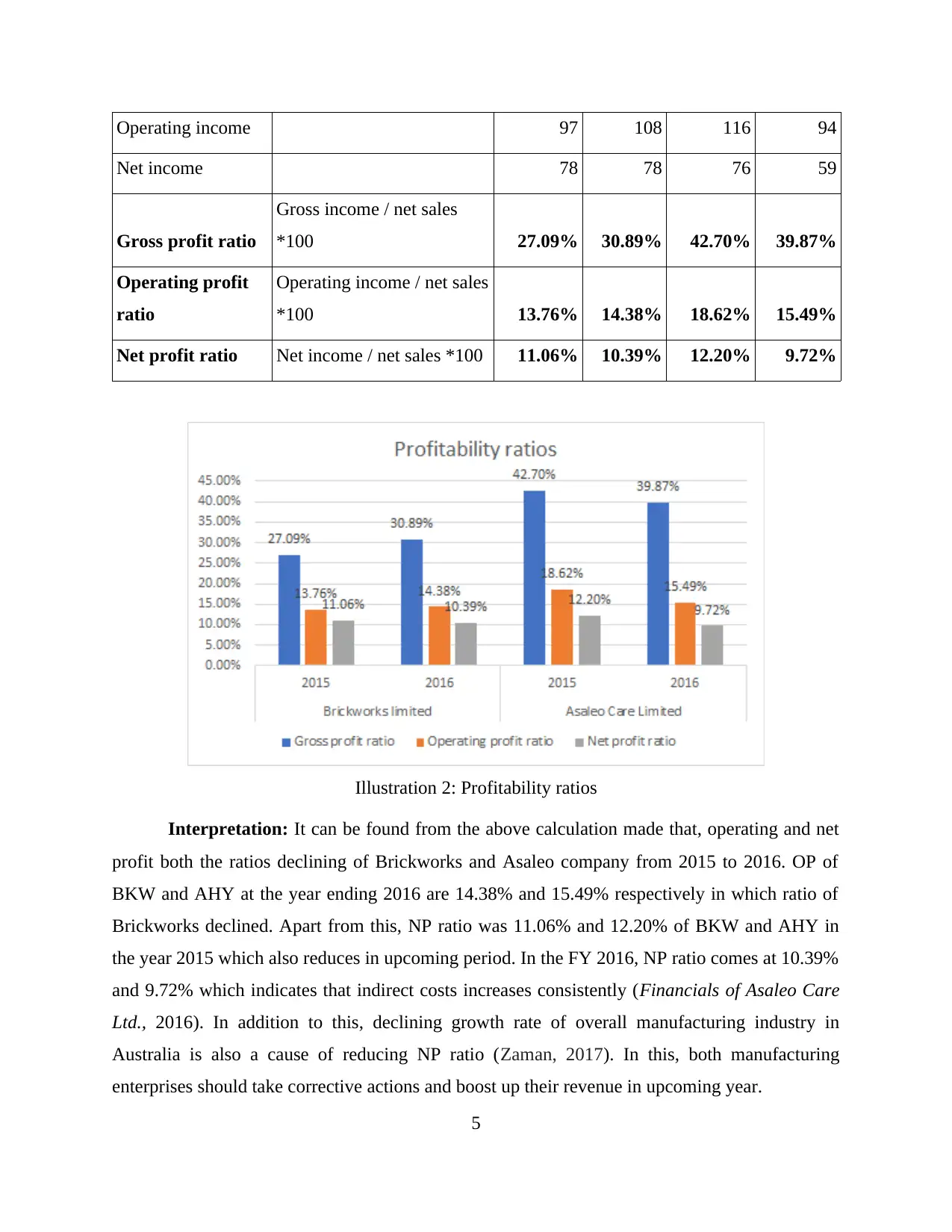
Operating income 97 108 116 94
Net income 78 78 76 59
Gross profit ratio
Gross income / net sales
*100 27.09% 30.89% 42.70% 39.87%
Operating profit
ratio
Operating income / net sales
*100 13.76% 14.38% 18.62% 15.49%
Net profit ratio Net income / net sales *100 11.06% 10.39% 12.20% 9.72%
Illustration 2: Profitability ratios
Interpretation: It can be found from the above calculation made that, operating and net
profit both the ratios declining of Brickworks and Asaleo company from 2015 to 2016. OP of
BKW and AHY at the year ending 2016 are 14.38% and 15.49% respectively in which ratio of
Brickworks declined. Apart from this, NP ratio was 11.06% and 12.20% of BKW and AHY in
the year 2015 which also reduces in upcoming period. In the FY 2016, NP ratio comes at 10.39%
and 9.72% which indicates that indirect costs increases consistently (Financials of Asaleo Care
Ltd., 2016). In addition to this, declining growth rate of overall manufacturing industry in
Australia is also a cause of reducing NP ratio (Zaman, 2017). In this, both manufacturing
enterprises should take corrective actions and boost up their revenue in upcoming year.
5
Net income 78 78 76 59
Gross profit ratio
Gross income / net sales
*100 27.09% 30.89% 42.70% 39.87%
Operating profit
ratio
Operating income / net sales
*100 13.76% 14.38% 18.62% 15.49%
Net profit ratio Net income / net sales *100 11.06% 10.39% 12.20% 9.72%
Illustration 2: Profitability ratios
Interpretation: It can be found from the above calculation made that, operating and net
profit both the ratios declining of Brickworks and Asaleo company from 2015 to 2016. OP of
BKW and AHY at the year ending 2016 are 14.38% and 15.49% respectively in which ratio of
Brickworks declined. Apart from this, NP ratio was 11.06% and 12.20% of BKW and AHY in
the year 2015 which also reduces in upcoming period. In the FY 2016, NP ratio comes at 10.39%
and 9.72% which indicates that indirect costs increases consistently (Financials of Asaleo Care
Ltd., 2016). In addition to this, declining growth rate of overall manufacturing industry in
Australia is also a cause of reducing NP ratio (Zaman, 2017). In this, both manufacturing
enterprises should take corrective actions and boost up their revenue in upcoming year.
5
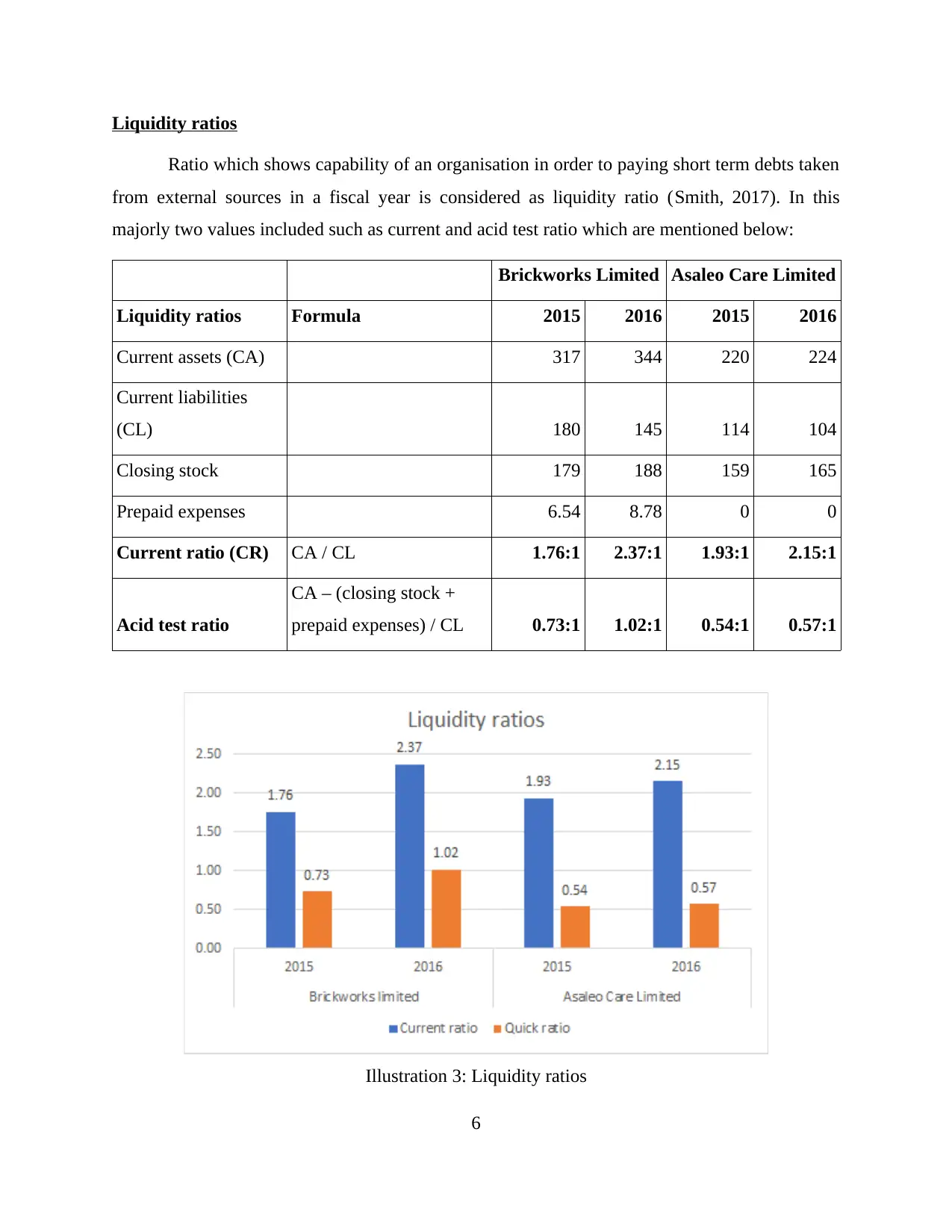
Liquidity ratios
Ratio which shows capability of an organisation in order to paying short term debts taken
from external sources in a fiscal year is considered as liquidity ratio (Smith, 2017). In this
majorly two values included such as current and acid test ratio which are mentioned below:
Brickworks Limited Asaleo Care Limited
Liquidity ratios Formula 2015 2016 2015 2016
Current assets (CA) 317 344 220 224
Current liabilities
(CL) 180 145 114 104
Closing stock 179 188 159 165
Prepaid expenses 6.54 8.78 0 0
Current ratio (CR) CA / CL 1.76:1 2.37:1 1.93:1 2.15:1
Acid test ratio
CA – (closing stock +
prepaid expenses) / CL 0.73:1 1.02:1 0.54:1 0.57:1
Illustration 3: Liquidity ratios
6
Ratio which shows capability of an organisation in order to paying short term debts taken
from external sources in a fiscal year is considered as liquidity ratio (Smith, 2017). In this
majorly two values included such as current and acid test ratio which are mentioned below:
Brickworks Limited Asaleo Care Limited
Liquidity ratios Formula 2015 2016 2015 2016
Current assets (CA) 317 344 220 224
Current liabilities
(CL) 180 145 114 104
Closing stock 179 188 159 165
Prepaid expenses 6.54 8.78 0 0
Current ratio (CR) CA / CL 1.76:1 2.37:1 1.93:1 2.15:1
Acid test ratio
CA – (closing stock +
prepaid expenses) / CL 0.73:1 1.02:1 0.54:1 0.57:1
Illustration 3: Liquidity ratios
6
Secure Best Marks with AI Grader
Need help grading? Try our AI Grader for instant feedback on your assignments.
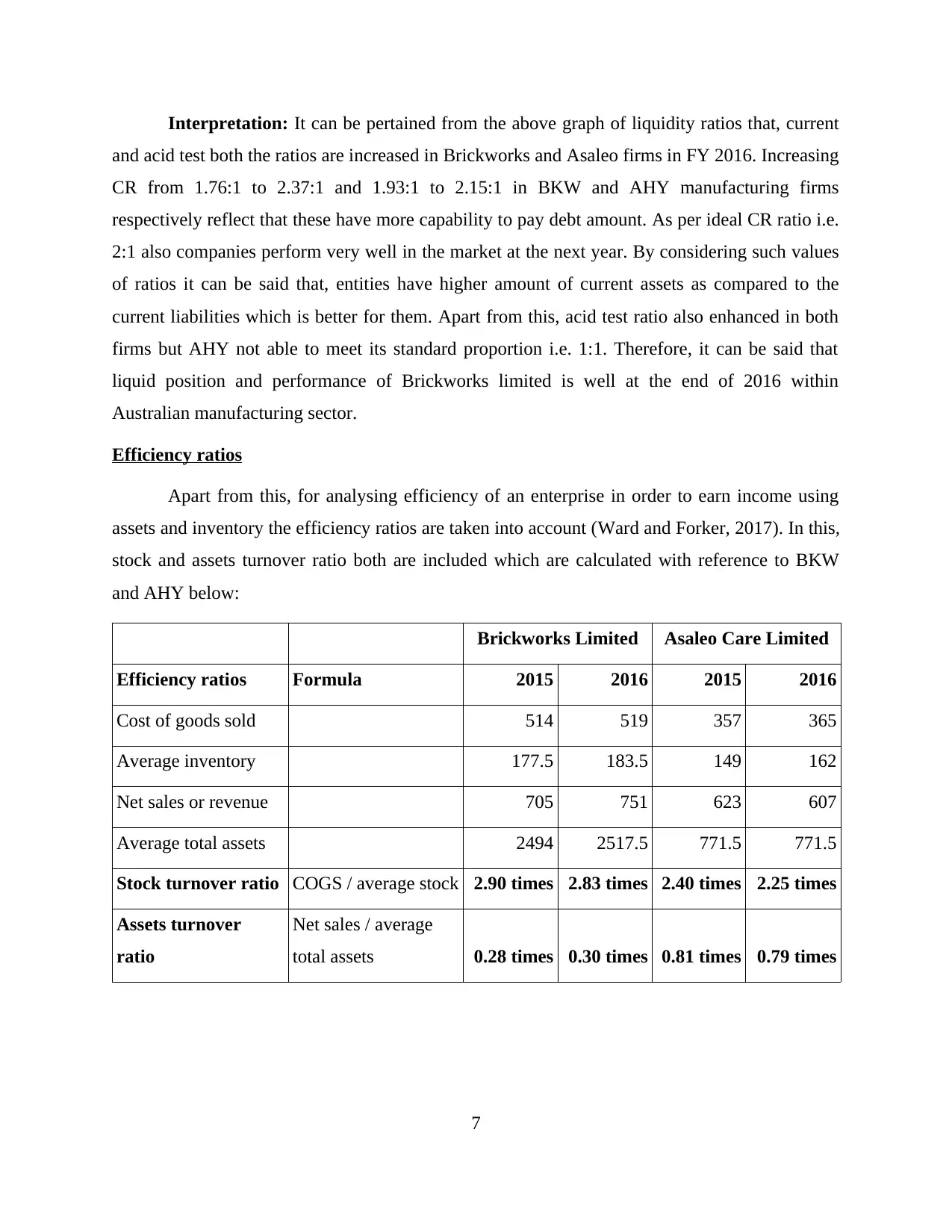
Interpretation: It can be pertained from the above graph of liquidity ratios that, current
and acid test both the ratios are increased in Brickworks and Asaleo firms in FY 2016. Increasing
CR from 1.76:1 to 2.37:1 and 1.93:1 to 2.15:1 in BKW and AHY manufacturing firms
respectively reflect that these have more capability to pay debt amount. As per ideal CR ratio i.e.
2:1 also companies perform very well in the market at the next year. By considering such values
of ratios it can be said that, entities have higher amount of current assets as compared to the
current liabilities which is better for them. Apart from this, acid test ratio also enhanced in both
firms but AHY not able to meet its standard proportion i.e. 1:1. Therefore, it can be said that
liquid position and performance of Brickworks limited is well at the end of 2016 within
Australian manufacturing sector.
Efficiency ratios
Apart from this, for analysing efficiency of an enterprise in order to earn income using
assets and inventory the efficiency ratios are taken into account (Ward and Forker, 2017). In this,
stock and assets turnover ratio both are included which are calculated with reference to BKW
and AHY below:
Brickworks Limited Asaleo Care Limited
Efficiency ratios Formula 2015 2016 2015 2016
Cost of goods sold 514 519 357 365
Average inventory 177.5 183.5 149 162
Net sales or revenue 705 751 623 607
Average total assets 2494 2517.5 771.5 771.5
Stock turnover ratio COGS / average stock 2.90 times 2.83 times 2.40 times 2.25 times
Assets turnover
ratio
Net sales / average
total assets 0.28 times 0.30 times 0.81 times 0.79 times
7
and acid test both the ratios are increased in Brickworks and Asaleo firms in FY 2016. Increasing
CR from 1.76:1 to 2.37:1 and 1.93:1 to 2.15:1 in BKW and AHY manufacturing firms
respectively reflect that these have more capability to pay debt amount. As per ideal CR ratio i.e.
2:1 also companies perform very well in the market at the next year. By considering such values
of ratios it can be said that, entities have higher amount of current assets as compared to the
current liabilities which is better for them. Apart from this, acid test ratio also enhanced in both
firms but AHY not able to meet its standard proportion i.e. 1:1. Therefore, it can be said that
liquid position and performance of Brickworks limited is well at the end of 2016 within
Australian manufacturing sector.
Efficiency ratios
Apart from this, for analysing efficiency of an enterprise in order to earn income using
assets and inventory the efficiency ratios are taken into account (Ward and Forker, 2017). In this,
stock and assets turnover ratio both are included which are calculated with reference to BKW
and AHY below:
Brickworks Limited Asaleo Care Limited
Efficiency ratios Formula 2015 2016 2015 2016
Cost of goods sold 514 519 357 365
Average inventory 177.5 183.5 149 162
Net sales or revenue 705 751 623 607
Average total assets 2494 2517.5 771.5 771.5
Stock turnover ratio COGS / average stock 2.90 times 2.83 times 2.40 times 2.25 times
Assets turnover
ratio
Net sales / average
total assets 0.28 times 0.30 times 0.81 times 0.79 times
7
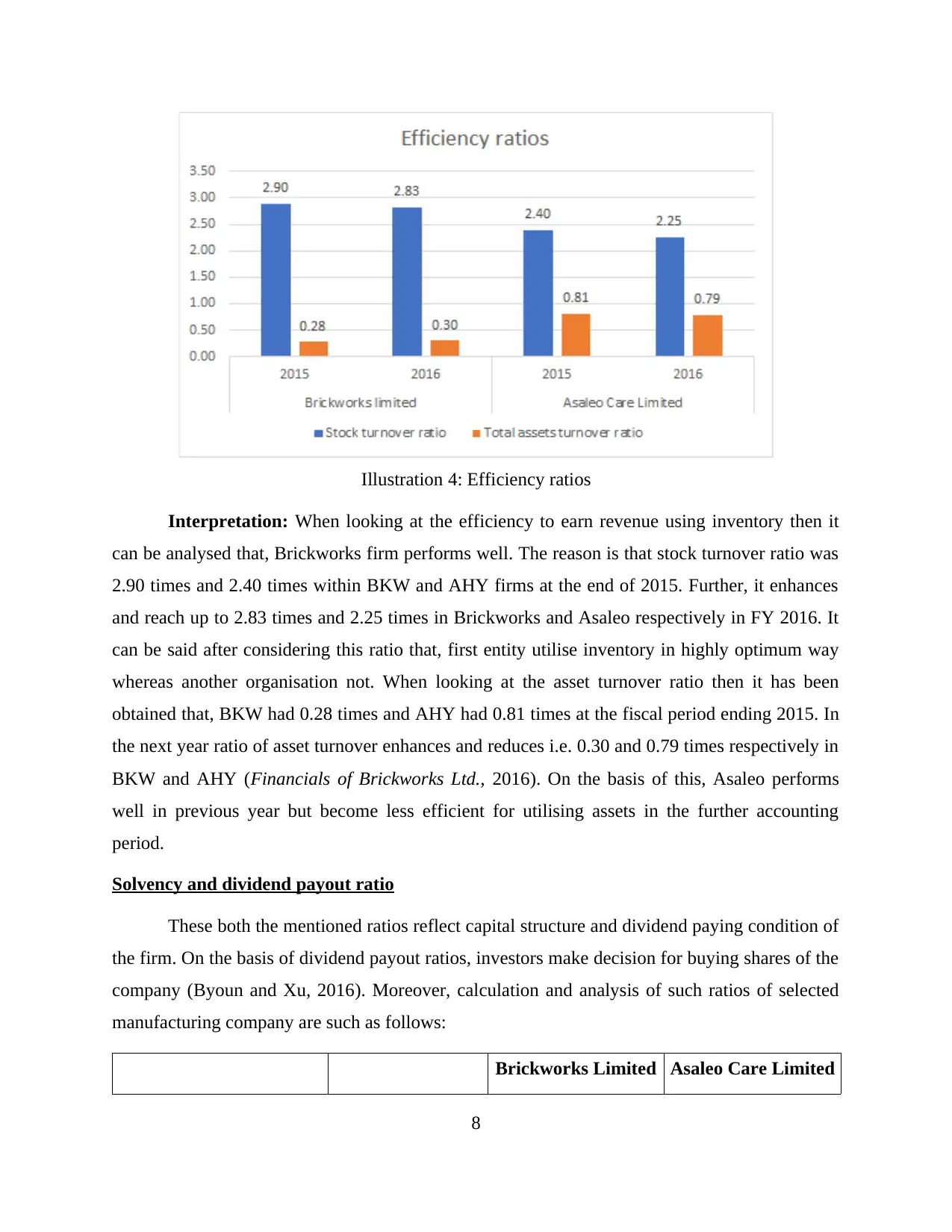
Illustration 4: Efficiency ratios
Interpretation: When looking at the efficiency to earn revenue using inventory then it
can be analysed that, Brickworks firm performs well. The reason is that stock turnover ratio was
2.90 times and 2.40 times within BKW and AHY firms at the end of 2015. Further, it enhances
and reach up to 2.83 times and 2.25 times in Brickworks and Asaleo respectively in FY 2016. It
can be said after considering this ratio that, first entity utilise inventory in highly optimum way
whereas another organisation not. When looking at the asset turnover ratio then it has been
obtained that, BKW had 0.28 times and AHY had 0.81 times at the fiscal period ending 2015. In
the next year ratio of asset turnover enhances and reduces i.e. 0.30 and 0.79 times respectively in
BKW and AHY (Financials of Brickworks Ltd., 2016). On the basis of this, Asaleo performs
well in previous year but become less efficient for utilising assets in the further accounting
period.
Solvency and dividend payout ratio
These both the mentioned ratios reflect capital structure and dividend paying condition of
the firm. On the basis of dividend payout ratios, investors make decision for buying shares of the
company (Byoun and Xu, 2016). Moreover, calculation and analysis of such ratios of selected
manufacturing company are such as follows:
Brickworks Limited Asaleo Care Limited
8
Interpretation: When looking at the efficiency to earn revenue using inventory then it
can be analysed that, Brickworks firm performs well. The reason is that stock turnover ratio was
2.90 times and 2.40 times within BKW and AHY firms at the end of 2015. Further, it enhances
and reach up to 2.83 times and 2.25 times in Brickworks and Asaleo respectively in FY 2016. It
can be said after considering this ratio that, first entity utilise inventory in highly optimum way
whereas another organisation not. When looking at the asset turnover ratio then it has been
obtained that, BKW had 0.28 times and AHY had 0.81 times at the fiscal period ending 2015. In
the next year ratio of asset turnover enhances and reduces i.e. 0.30 and 0.79 times respectively in
BKW and AHY (Financials of Brickworks Ltd., 2016). On the basis of this, Asaleo performs
well in previous year but become less efficient for utilising assets in the further accounting
period.
Solvency and dividend payout ratio
These both the mentioned ratios reflect capital structure and dividend paying condition of
the firm. On the basis of dividend payout ratios, investors make decision for buying shares of the
company (Byoun and Xu, 2016). Moreover, calculation and analysis of such ratios of selected
manufacturing company are such as follows:
Brickworks Limited Asaleo Care Limited
8
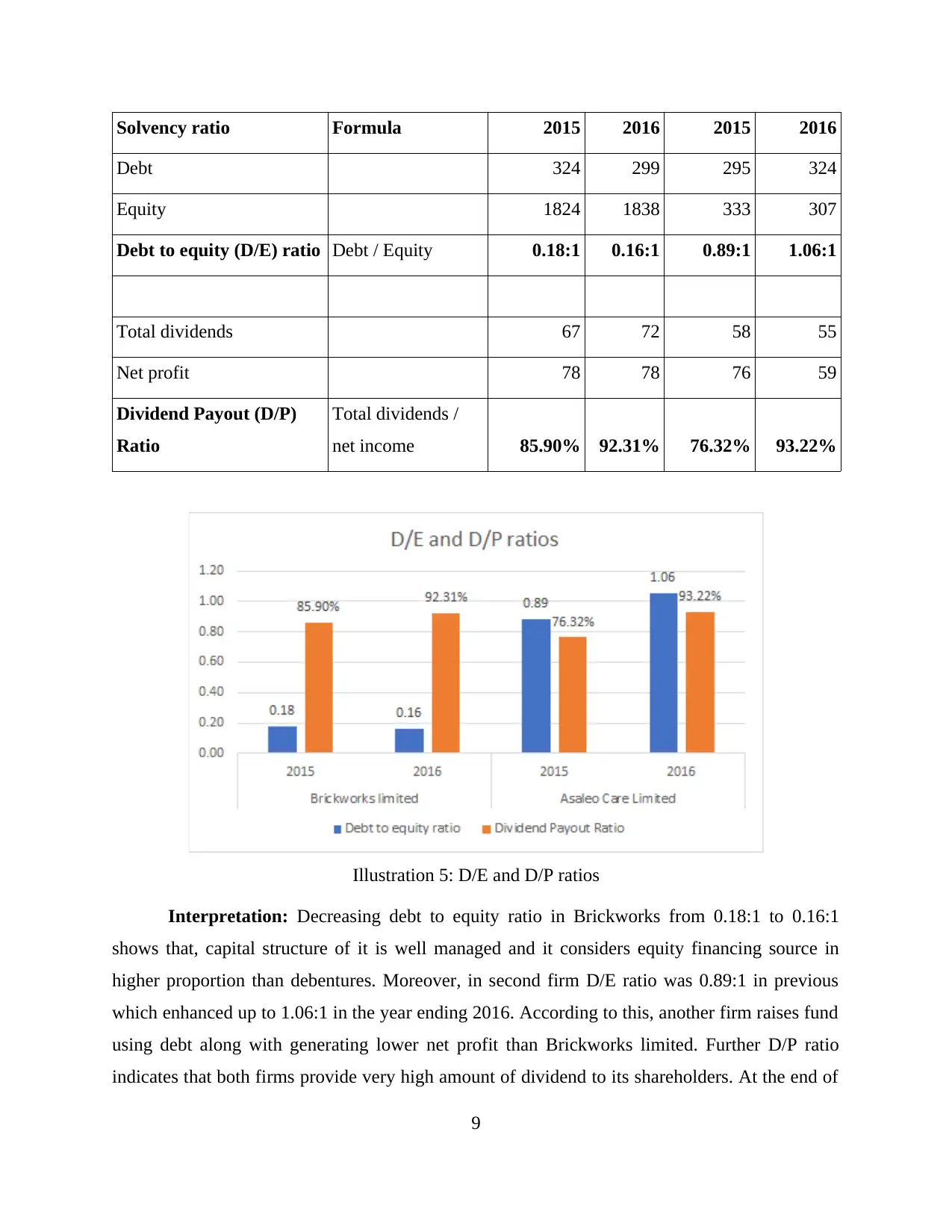
Solvency ratio Formula 2015 2016 2015 2016
Debt 324 299 295 324
Equity 1824 1838 333 307
Debt to equity (D/E) ratio Debt / Equity 0.18:1 0.16:1 0.89:1 1.06:1
Total dividends 67 72 58 55
Net profit 78 78 76 59
Dividend Payout (D/P)
Ratio
Total dividends /
net income 85.90% 92.31% 76.32% 93.22%
Illustration 5: D/E and D/P ratios
Interpretation: Decreasing debt to equity ratio in Brickworks from 0.18:1 to 0.16:1
shows that, capital structure of it is well managed and it considers equity financing source in
higher proportion than debentures. Moreover, in second firm D/E ratio was 0.89:1 in previous
which enhanced up to 1.06:1 in the year ending 2016. According to this, another firm raises fund
using debt along with generating lower net profit than Brickworks limited. Further D/P ratio
indicates that both firms provide very high amount of dividend to its shareholders. At the end of
9
Debt 324 299 295 324
Equity 1824 1838 333 307
Debt to equity (D/E) ratio Debt / Equity 0.18:1 0.16:1 0.89:1 1.06:1
Total dividends 67 72 58 55
Net profit 78 78 76 59
Dividend Payout (D/P)
Ratio
Total dividends /
net income 85.90% 92.31% 76.32% 93.22%
Illustration 5: D/E and D/P ratios
Interpretation: Decreasing debt to equity ratio in Brickworks from 0.18:1 to 0.16:1
shows that, capital structure of it is well managed and it considers equity financing source in
higher proportion than debentures. Moreover, in second firm D/E ratio was 0.89:1 in previous
which enhanced up to 1.06:1 in the year ending 2016. According to this, another firm raises fund
using debt along with generating lower net profit than Brickworks limited. Further D/P ratio
indicates that both firms provide very high amount of dividend to its shareholders. At the end of
9
Paraphrase This Document
Need a fresh take? Get an instant paraphrase of this document with our AI Paraphraser
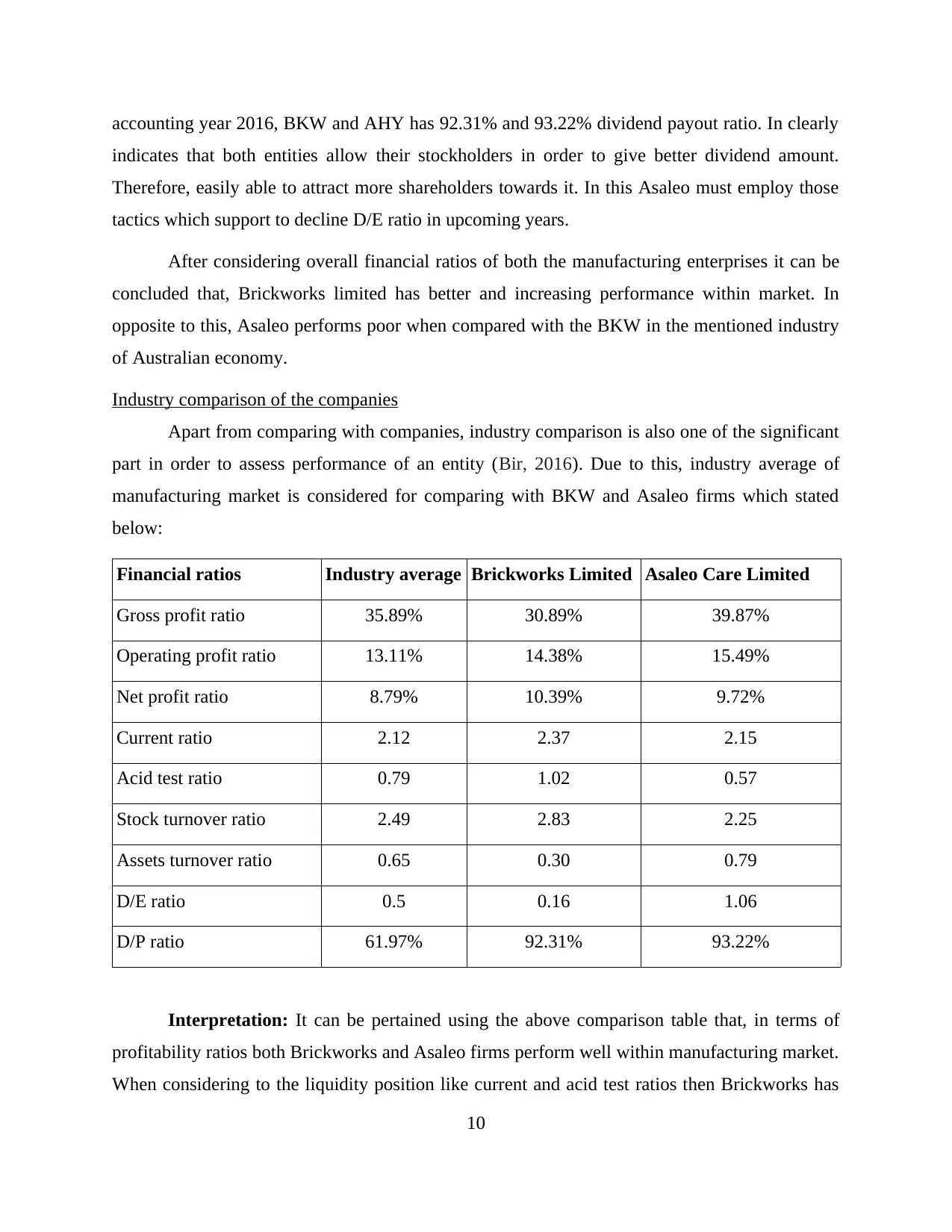
accounting year 2016, BKW and AHY has 92.31% and 93.22% dividend payout ratio. In clearly
indicates that both entities allow their stockholders in order to give better dividend amount.
Therefore, easily able to attract more shareholders towards it. In this Asaleo must employ those
tactics which support to decline D/E ratio in upcoming years.
After considering overall financial ratios of both the manufacturing enterprises it can be
concluded that, Brickworks limited has better and increasing performance within market. In
opposite to this, Asaleo performs poor when compared with the BKW in the mentioned industry
of Australian economy.
Industry comparison of the companies
Apart from comparing with companies, industry comparison is also one of the significant
part in order to assess performance of an entity (Bir, 2016). Due to this, industry average of
manufacturing market is considered for comparing with BKW and Asaleo firms which stated
below:
Financial ratios Industry average Brickworks Limited Asaleo Care Limited
Gross profit ratio 35.89% 30.89% 39.87%
Operating profit ratio 13.11% 14.38% 15.49%
Net profit ratio 8.79% 10.39% 9.72%
Current ratio 2.12 2.37 2.15
Acid test ratio 0.79 1.02 0.57
Stock turnover ratio 2.49 2.83 2.25
Assets turnover ratio 0.65 0.30 0.79
D/E ratio 0.5 0.16 1.06
D/P ratio 61.97% 92.31% 93.22%
Interpretation: It can be pertained using the above comparison table that, in terms of
profitability ratios both Brickworks and Asaleo firms perform well within manufacturing market.
When considering to the liquidity position like current and acid test ratios then Brickworks has
10
indicates that both entities allow their stockholders in order to give better dividend amount.
Therefore, easily able to attract more shareholders towards it. In this Asaleo must employ those
tactics which support to decline D/E ratio in upcoming years.
After considering overall financial ratios of both the manufacturing enterprises it can be
concluded that, Brickworks limited has better and increasing performance within market. In
opposite to this, Asaleo performs poor when compared with the BKW in the mentioned industry
of Australian economy.
Industry comparison of the companies
Apart from comparing with companies, industry comparison is also one of the significant
part in order to assess performance of an entity (Bir, 2016). Due to this, industry average of
manufacturing market is considered for comparing with BKW and Asaleo firms which stated
below:
Financial ratios Industry average Brickworks Limited Asaleo Care Limited
Gross profit ratio 35.89% 30.89% 39.87%
Operating profit ratio 13.11% 14.38% 15.49%
Net profit ratio 8.79% 10.39% 9.72%
Current ratio 2.12 2.37 2.15
Acid test ratio 0.79 1.02 0.57
Stock turnover ratio 2.49 2.83 2.25
Assets turnover ratio 0.65 0.30 0.79
D/E ratio 0.5 0.16 1.06
D/P ratio 61.97% 92.31% 93.22%
Interpretation: It can be pertained using the above comparison table that, in terms of
profitability ratios both Brickworks and Asaleo firms perform well within manufacturing market.
When considering to the liquidity position like current and acid test ratios then Brickworks has
10
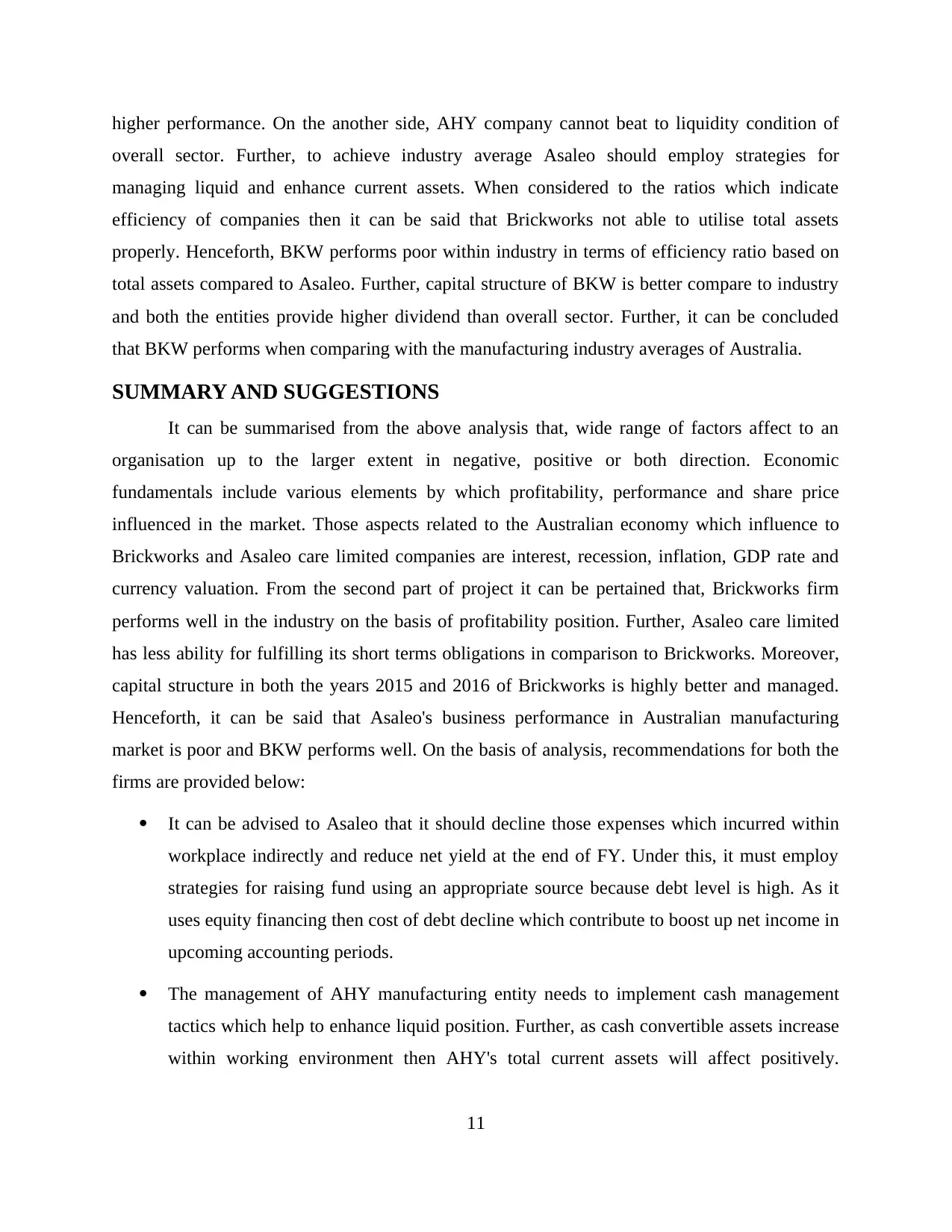
higher performance. On the another side, AHY company cannot beat to liquidity condition of
overall sector. Further, to achieve industry average Asaleo should employ strategies for
managing liquid and enhance current assets. When considered to the ratios which indicate
efficiency of companies then it can be said that Brickworks not able to utilise total assets
properly. Henceforth, BKW performs poor within industry in terms of efficiency ratio based on
total assets compared to Asaleo. Further, capital structure of BKW is better compare to industry
and both the entities provide higher dividend than overall sector. Further, it can be concluded
that BKW performs when comparing with the manufacturing industry averages of Australia.
SUMMARY AND SUGGESTIONS
It can be summarised from the above analysis that, wide range of factors affect to an
organisation up to the larger extent in negative, positive or both direction. Economic
fundamentals include various elements by which profitability, performance and share price
influenced in the market. Those aspects related to the Australian economy which influence to
Brickworks and Asaleo care limited companies are interest, recession, inflation, GDP rate and
currency valuation. From the second part of project it can be pertained that, Brickworks firm
performs well in the industry on the basis of profitability position. Further, Asaleo care limited
has less ability for fulfilling its short terms obligations in comparison to Brickworks. Moreover,
capital structure in both the years 2015 and 2016 of Brickworks is highly better and managed.
Henceforth, it can be said that Asaleo's business performance in Australian manufacturing
market is poor and BKW performs well. On the basis of analysis, recommendations for both the
firms are provided below:
It can be advised to Asaleo that it should decline those expenses which incurred within
workplace indirectly and reduce net yield at the end of FY. Under this, it must employ
strategies for raising fund using an appropriate source because debt level is high. As it
uses equity financing then cost of debt decline which contribute to boost up net income in
upcoming accounting periods.
The management of AHY manufacturing entity needs to implement cash management
tactics which help to enhance liquid position. Further, as cash convertible assets increase
within working environment then AHY's total current assets will affect positively.
11
overall sector. Further, to achieve industry average Asaleo should employ strategies for
managing liquid and enhance current assets. When considered to the ratios which indicate
efficiency of companies then it can be said that Brickworks not able to utilise total assets
properly. Henceforth, BKW performs poor within industry in terms of efficiency ratio based on
total assets compared to Asaleo. Further, capital structure of BKW is better compare to industry
and both the entities provide higher dividend than overall sector. Further, it can be concluded
that BKW performs when comparing with the manufacturing industry averages of Australia.
SUMMARY AND SUGGESTIONS
It can be summarised from the above analysis that, wide range of factors affect to an
organisation up to the larger extent in negative, positive or both direction. Economic
fundamentals include various elements by which profitability, performance and share price
influenced in the market. Those aspects related to the Australian economy which influence to
Brickworks and Asaleo care limited companies are interest, recession, inflation, GDP rate and
currency valuation. From the second part of project it can be pertained that, Brickworks firm
performs well in the industry on the basis of profitability position. Further, Asaleo care limited
has less ability for fulfilling its short terms obligations in comparison to Brickworks. Moreover,
capital structure in both the years 2015 and 2016 of Brickworks is highly better and managed.
Henceforth, it can be said that Asaleo's business performance in Australian manufacturing
market is poor and BKW performs well. On the basis of analysis, recommendations for both the
firms are provided below:
It can be advised to Asaleo that it should decline those expenses which incurred within
workplace indirectly and reduce net yield at the end of FY. Under this, it must employ
strategies for raising fund using an appropriate source because debt level is high. As it
uses equity financing then cost of debt decline which contribute to boost up net income in
upcoming accounting periods.
The management of AHY manufacturing entity needs to implement cash management
tactics which help to enhance liquid position. Further, as cash convertible assets increase
within working environment then AHY's total current assets will affect positively.
11
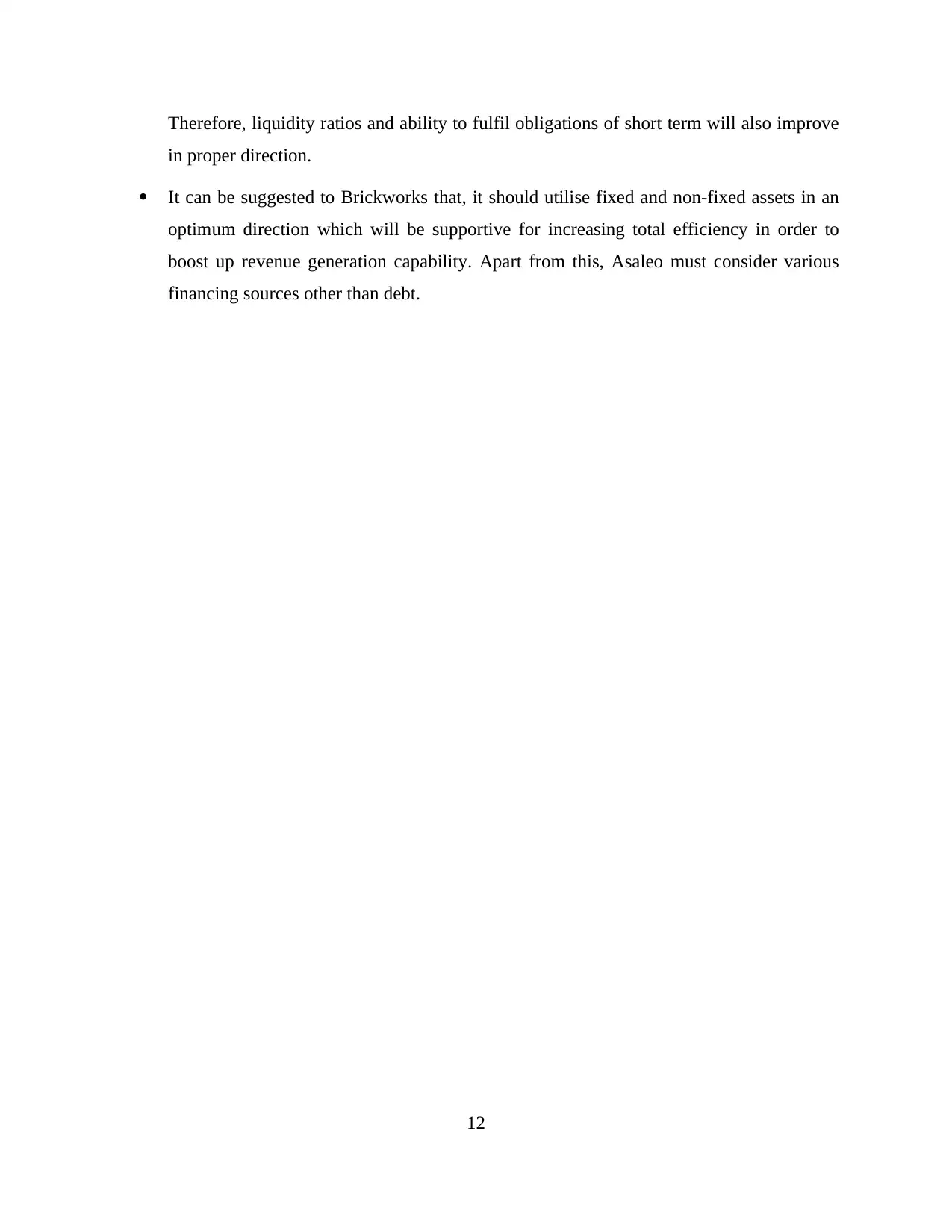
Therefore, liquidity ratios and ability to fulfil obligations of short term will also improve
in proper direction.
It can be suggested to Brickworks that, it should utilise fixed and non-fixed assets in an
optimum direction which will be supportive for increasing total efficiency in order to
boost up revenue generation capability. Apart from this, Asaleo must consider various
financing sources other than debt.
12
in proper direction.
It can be suggested to Brickworks that, it should utilise fixed and non-fixed assets in an
optimum direction which will be supportive for increasing total efficiency in order to
boost up revenue generation capability. Apart from this, Asaleo must consider various
financing sources other than debt.
12
Secure Best Marks with AI Grader
Need help grading? Try our AI Grader for instant feedback on your assignments.
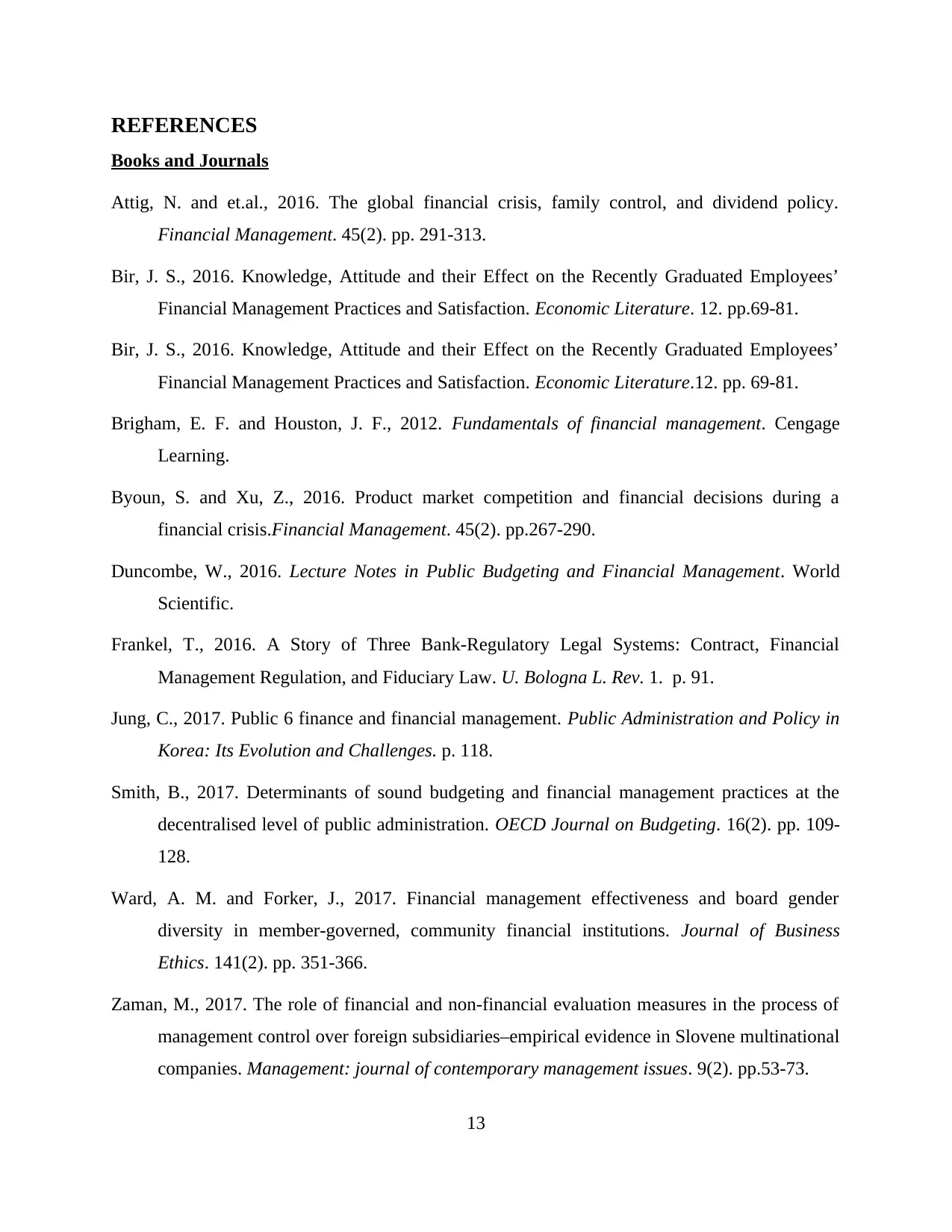
REFERENCES
Books and Journals
Attig, N. and et.al., 2016. The global financial crisis, family control, and dividend policy.
Financial Management. 45(2). pp. 291-313.
Bir, J. S., 2016. Knowledge, Attitude and their Effect on the Recently Graduated Employees’
Financial Management Practices and Satisfaction. Economic Literature. 12. pp.69-81.
Bir, J. S., 2016. Knowledge, Attitude and their Effect on the Recently Graduated Employees’
Financial Management Practices and Satisfaction. Economic Literature.12. pp. 69-81.
Brigham, E. F. and Houston, J. F., 2012. Fundamentals of financial management. Cengage
Learning.
Byoun, S. and Xu, Z., 2016. Product market competition and financial decisions during a
financial crisis.Financial Management. 45(2). pp.267-290.
Duncombe, W., 2016. Lecture Notes in Public Budgeting and Financial Management. World
Scientific.
Frankel, T., 2016. A Story of Three Bank-Regulatory Legal Systems: Contract, Financial
Management Regulation, and Fiduciary Law. U. Bologna L. Rev. 1. p. 91.
Jung, C., 2017. Public 6 finance and financial management. Public Administration and Policy in
Korea: Its Evolution and Challenges. p. 118.
Smith, B., 2017. Determinants of sound budgeting and financial management practices at the
decentralised level of public administration. OECD Journal on Budgeting. 16(2). pp. 109-
128.
Ward, A. M. and Forker, J., 2017. Financial management effectiveness and board gender
diversity in member-governed, community financial institutions. Journal of Business
Ethics. 141(2). pp. 351-366.
Zaman, M., 2017. The role of financial and non-financial evaluation measures in the process of
management control over foreign subsidiaries–empirical evidence in Slovene multinational
companies. Management: journal of contemporary management issues. 9(2). pp.53-73.
13
Books and Journals
Attig, N. and et.al., 2016. The global financial crisis, family control, and dividend policy.
Financial Management. 45(2). pp. 291-313.
Bir, J. S., 2016. Knowledge, Attitude and their Effect on the Recently Graduated Employees’
Financial Management Practices and Satisfaction. Economic Literature. 12. pp.69-81.
Bir, J. S., 2016. Knowledge, Attitude and their Effect on the Recently Graduated Employees’
Financial Management Practices and Satisfaction. Economic Literature.12. pp. 69-81.
Brigham, E. F. and Houston, J. F., 2012. Fundamentals of financial management. Cengage
Learning.
Byoun, S. and Xu, Z., 2016. Product market competition and financial decisions during a
financial crisis.Financial Management. 45(2). pp.267-290.
Duncombe, W., 2016. Lecture Notes in Public Budgeting and Financial Management. World
Scientific.
Frankel, T., 2016. A Story of Three Bank-Regulatory Legal Systems: Contract, Financial
Management Regulation, and Fiduciary Law. U. Bologna L. Rev. 1. p. 91.
Jung, C., 2017. Public 6 finance and financial management. Public Administration and Policy in
Korea: Its Evolution and Challenges. p. 118.
Smith, B., 2017. Determinants of sound budgeting and financial management practices at the
decentralised level of public administration. OECD Journal on Budgeting. 16(2). pp. 109-
128.
Ward, A. M. and Forker, J., 2017. Financial management effectiveness and board gender
diversity in member-governed, community financial institutions. Journal of Business
Ethics. 141(2). pp. 351-366.
Zaman, M., 2017. The role of financial and non-financial evaluation measures in the process of
management control over foreign subsidiaries–empirical evidence in Slovene multinational
companies. Management: journal of contemporary management issues. 9(2). pp.53-73.
13
1 out of 17
Related Documents
Your All-in-One AI-Powered Toolkit for Academic Success.
+13062052269
info@desklib.com
Available 24*7 on WhatsApp / Email
![[object Object]](/_next/static/media/star-bottom.7253800d.svg)
Unlock your academic potential
© 2024 | Zucol Services PVT LTD | All rights reserved.





